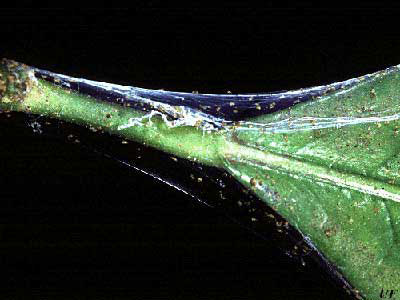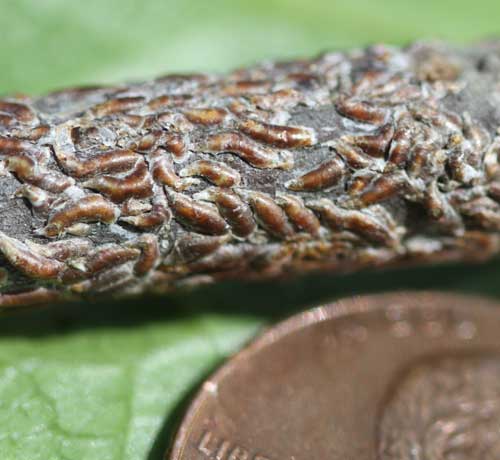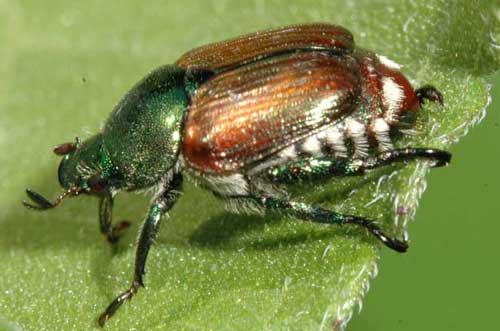The heat of the summer opens up the opportunity for a few pests to flourish on your plants.
 Spider Mites
Spider MitesThis tiny pest often goes unnoticed due to its size. You may noticed silvery stipples or spots on leaves. Many spider mites produce webbing, which is often found on the underside of leaves, or between leaves and stems. Shake the plant over a white piece of paper. If red dots appear on the paper, there are spider mites present.
Target plants: Vegetables, roses, lemons, limes, fruit trees, and flowering trees, shrubs, and perennials
Treat spider mites using Bon-Neem or Horticultural Oil, spraying once a week. Ensure to get good coverage of the entire plant, including under leaves and on buds. Spray plants in the early morning or late evening. Avoid spraying plants that have water stress or when temperatures are above 90°F.
 Scale Insects
Scale InsectsOften gardeners don't recognize scale as an insect because in its adult form it is hard, flat, and immobile. It resembles mineral or fertilizer residue and can be difficult to identify and eradicate. Frequently scale is only noticed because of its side effects; some produce a sweet substance called honeydew that attracts ants, bees, and flies. Honeydew can also encourage the growth of a black sooty mold on the plant surface.
Target plants: Evergreens, magnolia, dogwood, lilac, maple, willow
 Scale is most treatable in its adolescent, or "crawler," stage. Treat the young insects with any insecticide or insecticidal soap. Applying horticultural dormant oil in the early spring (before leaves appear on deciduous trees) may help tackle any scale before it reaches its mature and much less treatable stage. If you do find mature scale on your plants, you can try pruning off heavily infested areas, manually removing the scale, or encouraging natural predators such as birds and insects.
Scale is most treatable in its adolescent, or "crawler," stage. Treat the young insects with any insecticide or insecticidal soap. Applying horticultural dormant oil in the early spring (before leaves appear on deciduous trees) may help tackle any scale before it reaches its mature and much less treatable stage. If you do find mature scale on your plants, you can try pruning off heavily infested areas, manually removing the scale, or encouraging natural predators such as birds and insects.
These tiny flying insects swarm around a plant when it is disturbed. They are often found on the undersides of leaves. Drought and summer heat intensify infestations and allow for rapid reproduction. A few signs of whiteflies are curled leaves, stunted plant, stippling on the leaves, and black sooty mold.
 Target plants: Coleus, fuchsia, sweet potato vine, tomato, lemon, lime, squash plants, and flowering trees, shrubs, and perennials
Target plants: Coleus, fuchsia, sweet potato vine, tomato, lemon, lime, squash plants, and flowering trees, shrubs, and perennials
Treat whiteflies using Bon-Neem or Horticultural Oil, spraying once a week until the problem has gone away (usually requires 4-5 applications). Bonide Eight and Bonide Malathion can also be used as a method of control. Ensure to get good coverage of the entire plant, including under leaves and on buds. Spray plants in the early morning or late evening. Avoid spraying plants under water stress or when temperatures are above 90°F. Systemic treatments of Bayer Tree and Shrub 2in1 can be used.
 These beetles have dark metallic green heads and metallic dark tan wings. In July and August the beetles are often found feeding on leafy plants. The beetle may be present in areas that there are not grubs, as they fly long distances for food.
These beetles have dark metallic green heads and metallic dark tan wings. In July and August the beetles are often found feeding on leafy plants. The beetle may be present in areas that there are not grubs, as they fly long distances for food.
Target Plants: Roses, hibiscus, crab apple
Treat Japanese Beetles using Bonide Eight, Bonide Japanese Beetle Killer or Bonide Malathion, spraying once a week until control has been achieved without exceeding 10 applications per year. Japanese Beetle traps often attract more beetles to an area than they actually catch, therefore are oftentimes found to be ineffective.